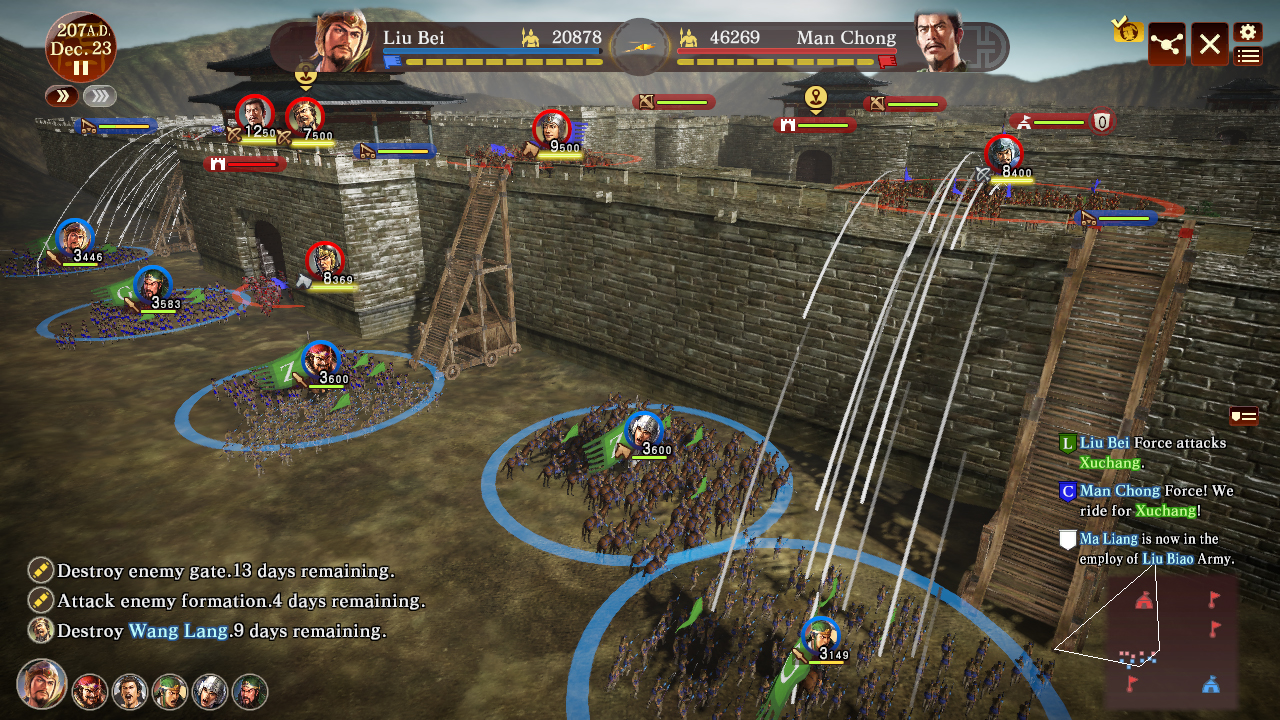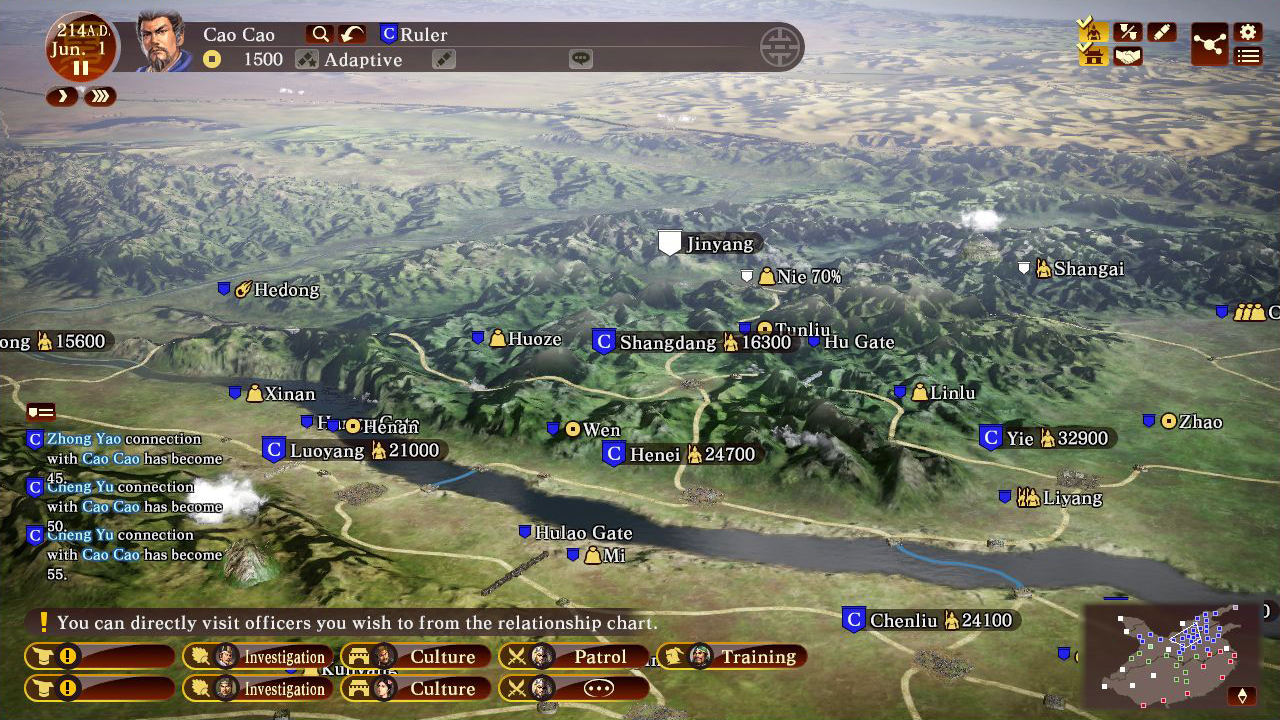Search
[{{{type}}}] {{{reason}}}
{{/data.error.root_cause}}{{{_source.title}}} {{#_source.showPrice}} {{{_source.displayPrice}}} {{/_source.showPrice}}
{{#_source.showLink}} {{/_source.showLink}} {{#_source.showDate}}{{{_source.displayDate}}}
{{/_source.showDate}}{{{_source.description}}}
{{#_source.additionalInfo}}{{#_source.additionalFields}} {{#title}} {{{label}}}: {{{title}}} {{/title}} {{/_source.additionalFields}}
{{/_source.additionalInfo}}- Details
- Category: PlayStation 4
- By Christopher Lancop
- Hits: 5335
Romance of the Three Kingdoms XIII (PS4)

Romance of the Three Kingdoms XIII
Developer: Koei Tecmo
Publisher: Koei Tecmo
Released: January 28, 2016, July 5, 2016 (Playstation 4)
Available On: Playstation 4, PC (PS3, Xbox One in Japan)
Number of Players: 1
ESRB Rating: E 10+ for Language, Mild Violence, Use of Alcohol
Price: $29.99
(Amazon Affiliate Link)
Thank you Koei Tecmo for sending us this game to review!
With the thirtieth anniversary of the series, Koei Tecmo has localized and released Romance of the Three Kingdoms XIII for Western audiences. The previous entry, Romance of the Three Kingdoms XII, was only released in Japan and Taiwan. The series has had a mixed reception outside Asian markets. Romance of the Three Kingdoms XI, for example, was criticized by reviewers for its slow game play, with IGN saying that “It will bore to tears” gamers who prefer flashier, more exciting games. The reception of this latest entry from Western reviewers so far, however, has been mixed at best. Does this game deserve the criticism it has received or is this entry a hidden gem?
As the name suggests, Romance of the Three Kingdoms XIII is based on Luo Guanzhong’s historical novel, which covers the Three Kingdoms era in Chinese history. Following the fall of the Han Dynasty, China was plunged into chaos with various warlords fighting for power. After decades of conflict, three kingdoms remained: Wei, led by Cao Cao; Shu Han, led by Liu Bei; and Wu led by Sun Quan. Their sixty year conflict is believed to be the bloodiest period in Chinese history, and the second bloodiest conflict in world history (following World War II). Unlike Koei Tecmo’s other Three Kingdoms series, Dynasty Warriors, Romance of the Three Kingdoms XIII takes few creative liberties with Luo Guanzhong’s work. Liu Bei is as he was portrayed in the historical novel, a selfless hero, while Cao Cao is the scheming villain. Though it's a worthwhile story for newcomers, it offers little for players already familiar with the material.
Romance of the Three Kingdoms XIII’s graphics varies. In game visuals are standard, if not substandard for this console generation. When viewed up close, character models, terrain and water graphics look fairly dated, very much out of place on the Playstation 4. This is probably due to the fact that the game was original developed for and released on the Playstation 3. Though the graphics do look better on the current generation system, it is clear that little effort was put into improving them. The issue, however, is that, in comparison to other strategy games’ in game graphics, Romance of the Three Kingdoms’ is either on par or a step above its competition. Many, like the Europa Universalis series, use a simple yet detailed map. Though the in game graphics are far from groundbreaking, the hand drawn character art and cinematics are very impressive. The game’s opening cinematic, Hero Mode cut scenes and character dialogue events strike the right tone, helping to better immerse players in the historic setting. You will not find the flashy costumes or loud rock music found in Dynasty Warriors series here. It is clear that an effort has been taken to be more historically accurate in both character designs and soundtrack. I found the background music very enjoyable, but for players who don’t, there is an Edit BGM option to change which music plays. Sadly, unlike other Koei Tecmo games, Romance of the Three Kingdoms does not have English audio. Players do, however, get a choice between Japanese and Chinese audio.
There are two modes of play in Romance of the Three Kingdoms XIII, Hero Mode and Main Mode. Hero Mode is little more than a tutorial mode that teaches players how to play the game while going through key moments in Three Kingdoms’ history. For example, the first tutorial, which teaches players how to move around the map and how to strengthen bonds between characters, follows the events of Liu Bei meeting Zhang Fei and Guan Yu, ending with the Peach Garden Oath where they swore fraternity to each other. The use of history to teach players game mechanics is interesting, but there is little reason to return to this mode after completing it.

Strong Points: Slow paced but fun strategy RPG that's loosly based off of Chinese history; free addon content
Weak Points: Dated visuals; steep learning curve
Moral Warnings: Violence; alcohol references; some attacks are element based
Main Mode is where the core of the game is. Players start off by choosing between one of seven scenarios, each taking place during different times in the Three Kingdoms era. After choosing a scenario, players can choose to play as an existing or original character (one they have created through the Edit Officer feature in the game’s main menu), and whether they want to swear loyalty to an existing lord or raise their flag and become a lord in a free city, and conquer all of China. No matter the path the player picks, becoming ruler of the land will take many hours, even on the easiest setting. Players must build up cities and recruit officers before they can go off to battle. Though it may sound tedious, it is actually quite addictive. Taking a city away from a rival army and rebuilding it to increase the size of your army and continue conquering the land is very rewarding.
Much of Romance of the Three Kingdoms’ gameplay consists of micromanagement. The amount of it depends on whether players are playing as a lord or an officer under them. If players choose to play as an officer, their duties and what actions they are allowed to take are dependent on rank. By completing missions, players can raise their rank, which in turn gives them more responsibilities. Regardless of whether the player is a lord or an officer, nearly all actions grant experience in the form of stat boosts. For example, participating in a duel will raise your character’s WAR stat, while conversing with another will increase your character’s Rapport with him or her. Strong bonds also give benefits in battles, so strengthening your character’s relationships with others is important. Training your soldiers is also important for battle. There is, however, little players can do if they do not manage their kingdoms well. For example without fealty (which can be raised through Patrols), players cannot raise an army. In this regard, players must micromanage both domestic and military affairs to be successful.
Combat in Romance of the Three Kingdoms is broken into two different types, personal combat and battles. Personal combat consists of debate and duels which are little more than a game of ‘rock-paper-scissors.’ Players choose an action to counter their opponents, with the defeated party losing health. Each fight lasts for five rounds, with the winner being the one who either reduces their opponent’s health to zero or has the most health at the end. Characters with the higher INT stat have the edge in debate, while characters with a higher WAR stat have the advantage in duels. Though interesting at first, these fights become tedious rather quickly, especially when having to constantly debate or duel the same low-level shopkeeper or bandit.

Higher is better
(10/10 is perfect)
Game Score - 72%
Gameplay - 14/20
Graphics - 6/10
Sound - 7/10
Stability - 5/5
Controls - 4/5
Morality Score - 85%
Violence - 6.5/10
Language - 10/10
Sexual Content - 8.5/10
Occult/Supernatural - 8.5/10
Cultural/Moral/Ethical - 8.5/10
Battles consist of military units fighting on land and water. Though most of the battle is done automatically, there are actions players can take to tilt it more in their favor. For example, capturing enemy bases will demoralize enemy soldiers, giving the player’s soldiers an advantage in battle. Players can also use special abilities to strengthen their soldiers and demoralize the opponents. Even proper troop position can give players an edge in battle as they pincer attack enemy armies. While players can allow the battle to progress automatically, I would recommend strict management. Pausing combat to reissue orders and activate special abilities is important when facing armies of equal or greater size. While frustrating at first, battles are one of the best parts of Romance of the Three Kingdoms XIII.
I would just like to add one final note on the gameplay and game content. There is a lot that players can do in Romance of the Three Kingdoms XIII, and a lot of different ways to go about it. For example, to have villages pledge allegiance to a city, the player can either placate them or subjugate them through military force. There are advantages and disadvantages to each action, meaning players have to decide which to take depending on the situation. In addition, there are many ways players can adjust their play session for more replay ability. Main Mode allows players to randomize officer location and change their behavior so as to not follow historical events. Players can also create their own officers who can be spouses and sworn siblings of historical officers or other fictional officers. Aside from the large amount of single player content there already is in the Romance of the Three Kingdoms XIII, there is also a fair amount of additional downloadable content, much of it free of charge. Considering how much additional scenarios and characters in other games cost, it is a pleasant surprise to see that Koei Tecmo is willing to give players free content. Suffice to say, there is a lot of content available for fans of strategy role playing games.
Given that Romance of the Three Kingdoms XIII is a game based loosely on Chinese history, there are no references to Christ or Christianity. That is not to say, however, that the game teaches immorality. Morality is defined in fairly universal black and white terms. Certain actions are seen as commendable and worthy of praise of loyalty, while others are scorned and breed disloyalty. For example, Liu Bei’s talk of bringing peace to the land earns him the loyalty of his sworn brothers Guan Yu and Zhang Fei, while Cao Cao’s desire to use the chaos to empower himself leads to Chen Gong’s betrayal. Acting friendly towards officers by presenting gifts and aiding them in completing tasks are rewarded, which in turn reinforces moral behavior among players. Although the game is set during China’s bloodiest conflict, there are no onscreen depictions of blood, even when officers are killed during events. Alcohol use is also rarely shown, though players can present alcoholic gifts to officers. It is no surprise that the game has an Everyone 10+ rating.
Romance of the Three Kingdoms XIII isn’t a game for everyone. It is hard to recommend this for Western gamers who tend to prefer fast paced action games. This is also not a game I would recommend for players who want something they can pick up and start playing right away either. It will take more than a few hours for players to understand basic game mechanics, even after completing Hero Mode. However, this is definitely a game for those who enjoy strategy role playing and learning about history. This type of player will be greatly rewarded with not only a unique experience, but enough content to make it well worth the game’s price. Even players looking for a variation from fast paced action games could find that Romance of the Three Kingdoms XIII is a welcome change.






